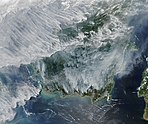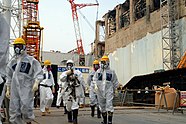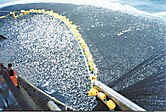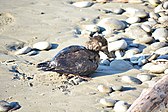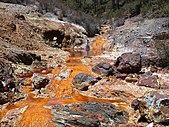
A | B | C | D | E | F | G | H | CH | I | J | K | L | M | N | O | P | Q | R | S | T | U | V | W | X | Y | Z | 0 | 1 | 2 | 3 | 4 | 5 | 6 | 7 | 8 | 9
- Top-left: Satellite image of Southeast Asian haze.
- Top-right: IAEA experts investigate the Fukushima disaster.
- Middle-left: a picture from 1997 of industrial fishing, a practice that has led to overfishing.
- Middle-right: a seabird during an oil spill.
- Bottom-left: Acid mine drainage in the Rio Tinto.
- Bottom-right: depiction of deforestation of Brazil's Atlantic forest by Portuguese settlers, c. 1820–25.
 |
| Environment |
|---|
|
| Part of a series on |
| Sociology |
|---|
 |
Human impact on the environment (or anthropogenic environmental impact) refers to changes to biophysical environments[1] and to ecosystems, biodiversity, and natural resources[2] caused directly or indirectly by humans. Modifying the environment to fit the needs of society (as in the built environment) is causing severe effects[3][4] including global warming,[1][5][6] environmental degradation[1] (such as ocean acidification[1][7]), mass extinction and biodiversity loss,[8][9][10] ecological crisis, and ecological collapse. Some human activities that cause damage (either directly or indirectly) to the environment on a global scale include population growth,[11][12][13] neoliberal economic policies[14][15][16] and rapid economic growth,[17] overconsumption, overexploitation, pollution, and deforestation. Some of the problems, including global warming and biodiversity loss, have been proposed as representing catastrophic risks to the survival of the human species.[18][19]
The term anthropogenic designates an effect or object resulting from human activity. The term was first used in the technical sense by Russian geologist Alexey Pavlov, and it was first used in English by British ecologist Arthur Tansley in reference to human influences on climax plant communities.[20] The atmospheric scientist Paul Crutzen introduced the term "Anthropocene" in the mid-1970s.[21] The term is sometimes used in the context of pollution produced from human activity since the start of the Agricultural Revolution but also applies broadly to all major human impacts on the environment.[22][23][24] Many of the actions taken by humans that contribute to a heated environment stem from the burning of fossil fuel from a variety of sources, such as: electricity, cars, planes, space heating, manufacturing, or the destruction of forests.[25]
Human overshoot
Overconsumption

Overconsumption is a situation where resource use has outpaced the sustainable capacity of the ecosystem. It can be measured by the ecological footprint, a resource accounting approach which compares human demand on ecosystems with the amount of planet matter ecosystems can renew. Estimates by the Global Footprint Network indicate that humanity's current demand is 70%[27] higher than the regeneration rate of all of the planet's ecosystems combined. A prolonged pattern of overconsumption leads to environmental degradation and the eventual loss of resource bases.
Humanity's overall impact on the planet is affected by many factors, not just the raw number of people. Their lifestyle (including overall affluence and resource use) and the pollution they generate (including carbon footprint) are equally important. In 2008, The New York Times stated that the inhabitants of the developed nations of the world consume resources like oil and metals at a rate almost 32 times greater than those of the developing world, who make up the majority of the human population.[28]
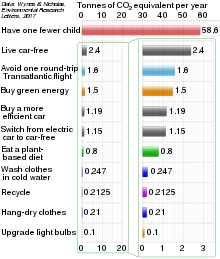
Human civilization has caused the loss of 83% of all wild mammals and half of plants.[29] The world's chickens are triple the weight of all the wild birds, while domesticated cattle and pigs outweigh all wild mammals by 14 to 1.[30][31] Global meat consumption is projected to more than double by 2050, perhaps as much as 76%, as the global population rises to more than 9 billion, which will be a significant driver of further biodiversity loss and increased Greenhouse gas emissions.[32][33]
Population growth and size

Some scholars, environmentalists and advocates have linked human population growth or population size as a driver of environmental issues, including some suggesting this indicates an overpopulation scenario.[11] In 2017, over 15,000 scientists around the world issued a second warning to humanity which asserted that rapid human population growth is the "primary driver behind many ecological and even societal threats."[36] According to the Global Assessment Report on Biodiversity and Ecosystem Services, released by the United Nations' Intergovernmental Science-Policy Platform on Biodiversity and Ecosystem Services in 2019, human population growth is a significant factor in contemporary biodiversity loss.[37] A 2021 report in Frontiers in Conservation Science proposed that population size and growth are significant factors in biodiversity loss, soil degradation and pollution.[38][39]
Some scientists and environmentalists, including Pentti Linkola,[40] Jared Diamond and E. O. Wilson, posit that human population growth is devastating to biodiversity. Wilson for example, has expressed concern that when Homo sapiens reached a population of six billion their biomass exceeded that of any other large land dwelling animal species that had ever existed by over 100 times.[41]
However, attributing overpopulation as a cause of environmental issues is controversial. Demographic projections indicate that population growth is slowing and world population will peak in the 21st century,[34] and many experts believe that global resources can meet this increased demand, suggesting a global overpopulation scenario is unlikely. Other projections have the population continuing to grow into the next century.[42] While some studies, including the British government's 2021 Economics of Biodiversity review, posit that population growth and overconsumption are interdependent,[43][44][45] critics suggest blaming overpopulation for environmental issues can unduly blame poor populations in the Global South or oversimplify more complex drivers, leading some to treat overconsumption as a separate issue.[46][47][48]
Advocates for further reducing fertility rates, among them Rodolfo Dirzo and Paul R. Ehrlich, argue that this reduction should primarily affect the "overconsuming wealthy and middle classes," with the ultimate goal being to shrink "the scale of the human enterprise" and reverse the "growthmania" which they say threatens biodiversity and the "life-support systems of humanity."[49]
Fishing and farming
The environmental impact of agriculture varies based on the wide variety of agricultural practices employed around the world. Ultimately, the environmental impact depends on the production practices of the system used by farmers. The connection between emissions into the environment and the farming system is indirect, as it also depends on other climate variables such as rainfall and temperature.

There are two types of indicators of environmental impact: "means-based", which is based on the farmer's production methods, and "effect-based", which is the impact that farming methods have on the farming system or on emissions to the environment. An example of a means-based indicator would be the quality of groundwater that is affected by the amount of nitrogen applied to the soil. An indicator reflecting the loss of nitrate to groundwater would be effect-based.[50]
The environmental impact of agriculture involves a variety of factors from the soil, to water, the air, animal and soil diversity, plants, and the food itself. Some of the environmental issues that are related to agriculture are climate change, deforestation, genetic engineering, irrigation problems, pollutants, soil degradation, and waste.
Fishing

The environmental impact of fishing can be divided into issues that involve the availability of fish to be caught, such as overfishing, sustainable fisheries, and fisheries management; and issues that involve the impact of fishing on other elements of the environment, such as by-catch and destruction of habitat such as coral reefs.[51] According to the 2019 Intergovernmental Science-Policy Platform on Biodiversity and Ecosystem Services report, overfishing is the main driver of mass species extinction in the oceans.[52]
These conservation issues are part of marine conservation, and are addressed in fisheries science programs. There is a growing gap between how many fish are available to be caught and humanity's desire to catch them, a problem that gets worse as the world population grows.[citation needed]
Similar to other environmental issues, there can be conflict between the fishermen who depend on fishing for their livelihoods and fishery scientists who realize that if future fish populations are to be sustainable then some fisheries must reduce or even close.[53]
The journal Science published a four-year study in November 2006, which predicted that, at prevailing trends, the world would run out of wild-caught seafood in 2048.[54] The scientists stated that the decline was a result of overfishing, pollution and other environmental factors that were reducing the population of fisheries at the same time as their ecosystems were being degraded. Yet again the analysis has met criticism as being fundamentally flawed, and many fishery management officials, industry representatives and scientists challenge the findings, although the debate continues. Many countries, such as Tonga, the United States, Australia and New Zealand, and international management bodies have taken steps to appropriately manage marine resources.[55][56]
The UN's Food and Agriculture Organization (FAO) released their biennial State of World Fisheries and Aquaculture in 2018[57] noting that capture fishery production has remained constant for the last two decades but unsustainable overfishing has increased to 33% of the world's fisheries. They also noted that aquaculture, the production of farmed fish, has increased from 120 million tonnes per year in 1990 to over 170 million tonnes in 2018.[58]
Populations of oceanic sharks and rays have been reduced by 71% since 1970, largely due to overfishing. More than three-quarters of the species comprising this group are now threatened with extinction.[59][60]
Irrigation
The environmental impact of irrigation includes the changes in quantity and quality of soil and water as a result of irrigation and the ensuing effects on natural and social conditions at the tail-end and downstream of the irrigation scheme.
The impacts stem from the changed hydrological conditions owing to the installation and operation of the scheme.
An irrigation scheme often draws water from the river and distributes it over the irrigated area. As a hydrological result it is found that:
- the downstream river discharge is reduced
- the evaporation in the scheme is increased
- the groundwater recharge in the scheme is increased
- the level of the water table rises
- the drainage flow is increased.
These may be called direct effects.
Effects on soil and water quality are indirect and complex, and subsequent impacts on natural, ecological and socio-economic conditions are intricate. In some, but not all instances, water logging and soil salinization can result. However, irrigation can also be used, together with soil drainage, to overcome soil salinization by leaching excess salts from the vicinity of the root zone.[61][62]
Irrigation can also be done extracting groundwater by (tube)wells. As a hydrological result it is found that the level of the water descends. The effects may be water mining, land/soil subsidence, and, along the coast, saltwater intrusion.
Irrigation projects can have large benefits, but the negative side effects are often overlooked.[63][64]
Agricultural irrigation technologies such as high powered water pumps, dams, and pipelines are responsible for the large-scale depletion of fresh water resources such as aquifers, lakes, and rivers. As a result of this massive diversion of freshwater, lakes, rivers, and creeks are running dry, severely altering or stressing surrounding ecosystems, and contributing to the extinction of many aquatic species.[65]
Zdroj:https://en.wikipedia.org?pojem=Human_impact_on_the_environmentText je dostupný za podmienok Creative Commons Attribution/Share-Alike License 3.0 Unported; prípadne za ďalších podmienok. Podrobnejšie informácie nájdete na stránke Podmienky použitia.
Antropológia
Aplikované vedy
Bibliometria
Dejiny vedy
Encyklopédie
Filozofia vedy
Forenzné vedy
Humanitné vedy
Knižničná veda
Kryogenika
Kryptológia
Kulturológia
Literárna veda
Medzidisciplinárne oblasti
Metódy kvantitatívnej analýzy
Metavedy
Metodika
Text je dostupný za podmienok Creative
Commons Attribution/Share-Alike License 3.0 Unported; prípadne za ďalších
podmienok.
Podrobnejšie informácie nájdete na stránke Podmienky
použitia.
www.astronomia.sk | www.biologia.sk | www.botanika.sk | www.dejiny.sk | www.economy.sk | www.elektrotechnika.sk | www.estetika.sk | www.farmakologia.sk | www.filozofia.sk | Fyzika | www.futurologia.sk | www.genetika.sk | www.chemia.sk | www.lingvistika.sk | www.politologia.sk | www.psychologia.sk | www.sexuologia.sk | www.sociologia.sk | www.veda.sk I www.zoologia.sk

